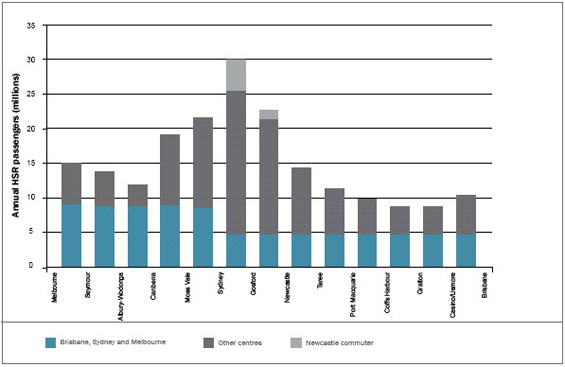How important are the regions for HSR?
Posted: August 7, 2011 Filed under: HSR High Speed Rail | Tags: AECOM, air services, Anthony Albanese, aviation, High Speed Rail, HSR, regions, SKM, train 8 CommentsThe exhibit above is one of the ‘money’ graphs from the High Speed Rail study – Phase One report released on Thursday by the Minister for Transport, Anthony Albanese. In my last post, I concentrated on doing a broad but quick response to the report and questioned the wisdom of spending mega dollars on a project that doesn’t reduce either travel times or the cost of travel.
Now I want to start exploring some issues the report raises. One of those is that, up to this point, the focus of the HSR discussion has largely been around travel between major cities, especially Sydney-Canberra-Melbourne, with some residual claims for regional development (see Categories in the side pane for previous posts on HSR).
The Phase One report however shows regional trips are a very large component of the travel forecast on the complete Brisbane to Melbourne HSR network in 2036. In fact regional travellers – those who are journeying between regional areas and one of the major cities – comprise an extraordinary 75% of forecast demand in 2036 (see exhibit). These are the sorts of trips that are almost all currently made by car. A significant proportion are also “induced” trips – in the absence of HSR and the greater accessibility it provides, they wouldn’t otherwise be made.
Only a small proportion of regional trips are for business purposes. The vast majority – 85% – are for private or leisure purposes i.e. to visit friends or relatives, holidays, entertainment, sport, shopping, education, personal or health-related purposes. The study assumes leisure passengers will pay a lower fare than business travellers (who are concentrated on the inter-city services, e.g. Sydney-Melbourne, where they account for 50% of passengers).
Regional trips are also shorter on average (they comprise half of all HSR passenger kilometres), so the contribution of regional travellers to total revenue is much lower than their 75% share of patronage. Even so, as with airlines at present, their contribution is vital.
There are a number of issues raised by the high level of forecast regional patronage. One is that leisure travellers are sensitive to the cost of travel. The study assumes HSR fares are pitched a little lower than air fares, but if this assumption proves optimistic the demand for HSR could be much lower. Unfortunately there’s no estimate provided for regional travellers, but for inter-city travel the study says a 10% increase in fares will reduce patronage by 10%, and vice versa.
In estimating demand, the study compares the cost of travel by HSR between the regions and the major cities against the car, but doesn’t allow for the usefulness of having a car when travelling within the big smoke. HSR will certainly suit people going (say) from Seymour to the MCG – they can drive to their nearest HSR station (they’ll be about 100 km apart in the regions), disembark at Southern Cross and take a local train/tram combination to get to the G. If however they’re not going to the city centre – perhaps they’re attending a wedding, a party or staying overnight with one of the 90% of the population who lives more than 5 km from the CBD – they might prefer the convenience of having a car for travel within Melbourne.
The car will be a more attractive option the closer regional residents live to the city, although anyone familiar with Canberra will know of the large numbers of young people who commonly drive to Sydney on weekends. Another thing to note is car occupancy for leisure travel is much higher than it is for commuting (where solo driving predominates). Two people travelling (say) to Sydney from Gosford for a concert would pay $26 each per one-way trip on HSR i.e. a combined total of $104 to get to and from Central station. Once the novelty of HSR has subsided, driving could be a more attractive alternative for many.
The big issue to my mind though is just why we as a society would want to spend so much money to improve the leisure travel options of regional populations living along Australia’s east coast. Doubtless they deserve it and would appreciate it, but they already have pretty reasonable travel choices. Last time I drove the Hume Highway from Sydney to Melbourne (about five years ago) it was divided carriageway practically all the way. Large centres like Wagga Wagga and Albury-Wodonga have pretty good air connections to Sydney and Melbourne. There’s already (an admittedly slowish) train service connecting Brisbane, Sydney and Melbourne. Read the rest of this entry »
